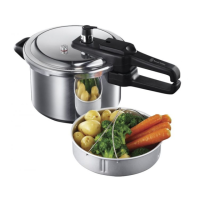34 Hold the body handle steady, push the lid lock fully in, towards the vent pipe, and hold it
there while you turn the lid handle anti-clockwise.
35 When the mark on the lid is aligned with the mark on the body handle, you can lift the lid up
and off the body (using the handle).
pre-steaming
Some recipes, such as puddings, require a period of pre-steaming before being brought to
cooking temperature. Pre-steaming should be done in a closed cooker on a medium heat with
the weight left off.
Make sure there’s enough water in the cooker to cover the pre-steaming and the normal
cooking time. If in doubt, remove the lid and check the water level before moving from
pre-steaming to pressure cooking.
Once the cooker is steaming, the heat should be reduced till only a small amount of steam
escapes. Don’t let the water boil rapidly, as too much steam will be given off, and the cooker
might boil dry before the end of the cooking time.
When pre-steaming time is done, check there’s enough water in the cooker, fit the weight, close
the pressure cooker, and increase the heat, to bring the cooker up to cooking pressure.
containers
Use basins, bowls, moulds or dishes that fit easily into the cooker. They mustn’t come to within
2.5cm (1”) of the top of the cooker body. Any type of heatproof container may be used: metal,
enamel, glass, earthenware or boilable plastic. Don’t use containers that are cracked.
using a lifting strap
When cooking in a container, put a thickly folded strip of aluminium foil
under the container, to use as a lifting strap. Make sure the ends of the strap
aren’t long enough to reach the underside of the lid, to avoid blocking the
pressure indicator and pressure selector tube. Grip the ends of the strap,
not the hot container.
caution use oven gloves – the foil will be hot, and you’re almost guaranteed to touch the hot
container and/or the body of the pressure cooker
advantages of pressure cooking
economical Cooks up to three times faster and uses only one element or ring, saving both
time and fuel.
nutritional Cooking under pressure is recognised as one of the healthiest ways to prepare
food. More vitamins and minerals are retained, with minimum loss of colour and
flavour, compared with conventional cooking.
versatile Cheaper, tougher cuts of meat will be tenderised. Bulk cooking/blanching for the
freezer is easier in a pressure cooker.
how pressure cooking works
Under normal conditions, water boils at a temperature of 100°C. If the pressure is raised, the
boiling point also rises. The pressure cooker has been designed to allow pressure to build up
safely in the cooker, increasing the cooking temperature. This results in cooking times up to 3
times faster than normal, and delicious tender food.
cooking times
Cooking times are determined by the size of the pieces of food. It’s best to cut foods to a
uniform size (e.g. potatoes, swede) if they’re going to be cooked together. If necessary, cooking
may be interrupted, pressure released, and foods with shorter cooking times added later.

